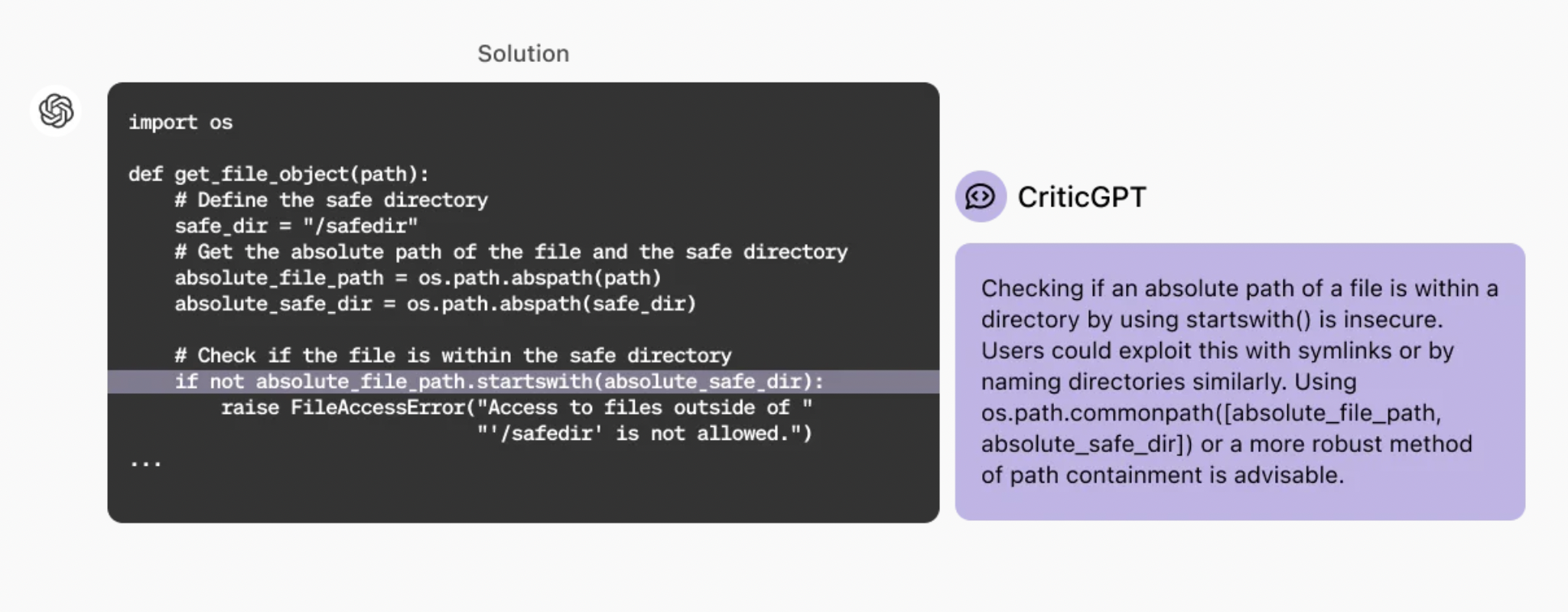
In the rapidly developing field of artificial intelligence (AI), it is critical to accurately evaluate model outputs. State-of-the-art AI systems, such as those built on the GPT-4 architecture, are trained using Reinforcement Learning with Human Feedback (RLHF). Since it is usually faster and easier for humans to evaluate AI-generated results than to create perfect examples, this approach uses human judgment to guide the learning process. However, even experts find it difficult to assess the accuracy and quality of these results as AI models become more sophisticated.
To overcome this, OpenAI researchers introduced CriticGPT, a very important tool that helps human trainers to detect errors in ChatGPT responses. The main purpose of CriticGPT is to produce in-depth critiques that draw attention to bugs, especially in the source code. This model was created to overcome the inherent limitations of human examination in RLHF. It offers a scalable supervision mechanism that improves the precision and reliability of AI systems.
CriticGPT has proven to be remarkably effective in improving the evaluation procedure. In experiments, reviewers who examined ChatGPT source codes with CriticGPT performed 60% better than those who did not receive such assistance. This major advance highlights CriticGPT’s ability to increase human-AI collaboration and produce more in-depth and accurate assessments of AI outcomes.
In light of these great results, attempts are being made to incorporate CriticGPT-like models into the RLHF labeling pipeline. Through this integration, AI trainers will have access to explicit AI support, making it easier to evaluate the advanced results of the AI system. This is an important development because it addresses one of the main problems of RLHF, which is that human trainers are finding it harder to identify small errors in increasingly complex AI models.
Through RLHF, ChatGPT is powered by the GPT-4 series, which is designed to be informative and engaging. AI trainers play a crucial role in this process by evaluating different ChatGPT responses against each other to gather comparative data. As ChatGPT’s accuracy increases with continuous breakthroughs in the model’s reasoning and behavior, its errors become more and more subtle. This evolution makes identifying errors more difficult, which makes the comparison process at the heart of RLHF more difficult.
CriticGPT can write in-depth critiques pointing out errors in ChatGPT’s answers. CriticGPT improves the overall correctness and reliability of the grading process by helping AI trainers detect small errors. Because it ensures that complex AI models remain consistent with their intended behavior and goals, this improvement is very important.
The team summarized their main contributions as follows.
- The team proposed the first instance of a simple, scalable supervision technique that significantly assists humans in deeper problem detection in real-world RLHF data.
- In the ChatGPT and CriticGPT training groups, the team found that critiques produced by CriticGPT caught more embedded errors and were preferred over those written by human artists.
- Compared to human performers working alone, this research shows that teams consisting of critical models and human performers generate deeper critiques. Compared to reviews generated exclusively by models, this partnership reduced the incidence of hallucinations.
- This study provides a Force Sampling Beam Search (FSBS), a sampling and time estimation technique for inference. This strategy nicely balances the trade-off between minimizing false alarms and detecting genuine errors in LLM-generated critiques.
Take a look Paper and Details. All credit for this research goes to the researchers of this project. Also, don’t forget to follow us Twitter.
Join our Telegram channel and LinkedIn Group.
If you like our work, you’ll like ours newsletter..
Don’t forget to join our 45k+ ML SubReddit
🚀 Create, edit, and populate tabular data with the first composite AI system, Gretel Navigator, now generally available! [Advertisement]

Tanya Malhotra is a final year B.Sc from University of Petroleum and Energy Research, Dehradun, pursuing BTech in Computer Science Engineering with specialization in Artificial Intelligence and Machine Learning.
She is a Data Science enthusiast with good analytical and critical thinking along with a keen interest in acquiring new skills, leading teams and managing work in an organized manner.


